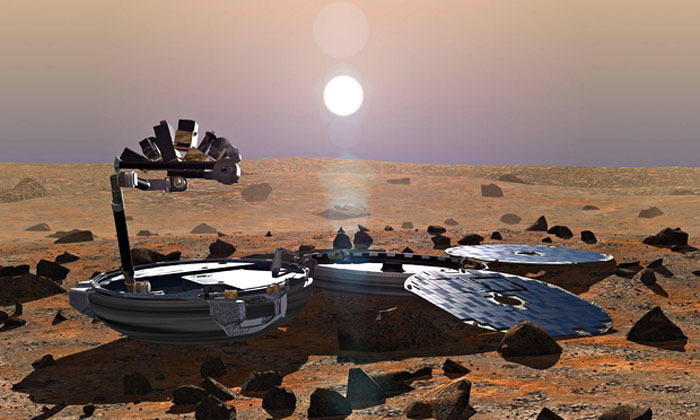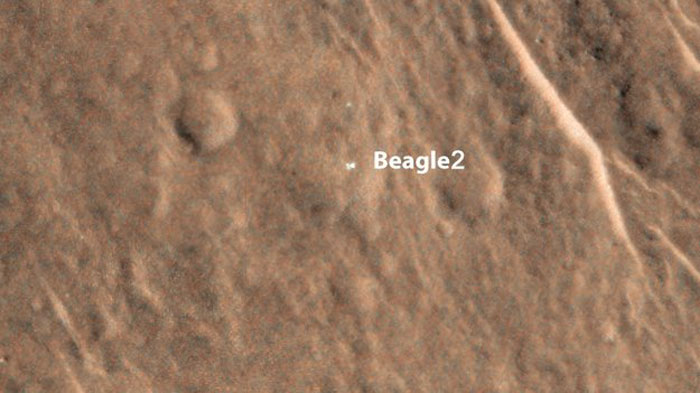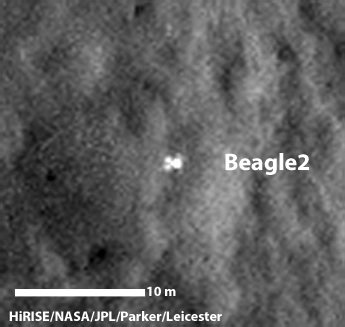.
16.01.2015

Press conference on Friday will provide an update on the fate of the Mars spacecraft that disappeared on Christmas day in 2003
-
A British Mars lander that was lost on its way to the red planet more than a decade ago may have been spotted by an orbiting spacecraft.
The Beagle 2 lander was supposed to touch down on Christmas day in 2003, but after it was released from its mothership, Mars Express, the dustbin-lid-sized craft was never heard from again.
But Beagle 2’s final resting place may finally have been discovered. Scientists operating the HiRise camera on Nasa’s Mars Reconnaissance Orbiter (MRO) will take part in a press conference this Friday to announce “an update” on the ill-fated mission.
The HiRise camera is the only camera in Mars orbit that can image the surface in high enough detail to spot missing spacecraft. The HiRise team has already found the twin Viking landers which touched down on Mars in the 1970s and photographed Nasa’s Phoenix, Curiosity and Opportunity rovers. They have been actively hunting for Beagle 2 for several years.
“HiRise is the only camera at Mars that can see former spacecraft like Beagle 2. It’s definitely pretty close to its intended landing spot, no matter what. It entered the atmosphere at the right time and place,” said Shane Byrne, a scientist on the HiRise team at the University of Arizona. He said the team has been asked to keep more details of the announcement under wraps.
Built on a shoestring budget, Beagle 2 was meant to announce its arrival on Mars by playing a musical call sign written by the Britpop band Blur. But despite astronomers listening for the lander’s signature tune with some of the most sophisticated receivers on Earth, all they heard was silence.
Led by the late planetary scientist, Colin Pillinger at the Open University, Beagle 2 was designed to look for signs of life on Mars and carried a drilling instrument to poke beneath the surface. Its release from the European Space Agency’s orbiter, Mars Express, went smoothly, placing Beagle 2 on course for a landing site at Isidis Planitia, a huge plain near the Martian equator.
The lander was meant to deploy a parachute on its way down to the Martian surface and inflate triple air bags at the last minute to cushion the impact. When the spacecraft failed to call home, many space scientists suspected it had broken up on impact.
The UK Space Agency sparked rumours that remnants of the lander had been found when it scheduled a press conference on Friday 16 January to announce an update on the Beagle 2 lander.
“The spacecraft was successfully released on 19th December 2003, and was due to land on Mars on 25th December 2003. Nothing has been heard from Beagle 2 since,” the notice said.
Mark Sims, professor of astrobiology and space instrumentation at Leicester University, who led a internal inquiry into why Beagle 2 failed to call home, declined to comment on whether the lander had been found.


But another space scientist who spoke to the Guardian, who asked not to be named, said that the remains of the lost lander might have been spotted with the HiRise camera. With a new image-processing technique that overlays multiple images, the camera can pick out features as small as 5cm across on the Martian surface.
Pictures of the lost lander would be of huge interest to space scientists who are planning future missions to Mars, such as the European Space Agency’s Exomars mission, which is due to launch in 2018 and land the year after. “Whatever happens with space missions, there are always lessons to be learned for future missions. Anything about Beagle 2 would be useful in terms of narrowing down exactly what did go wrong,” the space scientist said.
John Bridges at Leicester University, a member of the HiRISE camera team, will be at the press conference, along with David Parker the chief executive of the UK Space Agency.The Beagle 2 lander, which looked like two dustbin lids fused together, was 95cm in diameter. If the lander hit hard, the wreckage could be strewn over a much larger area. Beagle 2’s parachute and airbags should be easier to spot if they deployed properly and were not blown away by Martian dust storms. These could lead back to the lander itself.
Ian Crawford, a panetary scientist at Birkbeck, University of London, said that even though finding Beagle 2 would not have much scientific value, knowing its fate was still important. “People would like to know what happened to it. Knowing where it crashed, if it did crash, could be useful for people trying to work out what went wrong. If it landed more or less where it was supposed to land, then that at least gives you some confidence that the entry worked.”
Researchers in charge of the HiRise camera at the University of Arizona have taken repeated high-resolution images of the part of Isidis basin where Beagle 2 was due to land.
“We always realise in practice that we could have done things differently or better. And when things go wrong, if we can determine why it went wrong, then that’s invaluable,” said John Zarnecki, a planetary scientist at Open University.
Quelle: theguardian
.
Has Cambridge professor Colin Pillinger's Beagle 2 Mars probe been discovered after 11 years?
THE doomed Beagle 2 Mars probe, the brainchild of popular Cambridge scientist Professor Colin Pillinger, may have been spotted near its intended landing site on the Red Planet.
Yesterday the UK Space Agency announced it would provide an "update" on the ill-fated craft, which vanished while attempting a Christmas Day landing on the planet in 2003, in a briefing on Friday but is refusing to discuss in advance what will be revealed.
But according to The Times, a senior space scientist who has had sight of the images of Nasa's Mars Reconnaissance Orbiter said they showed an object "about the right shape and in about the right place" to be the lost lander.
The paper's source added: "It tells us how close it got to the right landing spot and that it was in one piece."
And Shane Byrne, a scientist at the University of Arizona operating a highly-detailed camera called HiRise, told The Guardian: "HiRise is the only camera at Mars that can see former spacecraft like Beagle 2. It's definitely pretty close to its intended landing spot, no matter what. It entered the atmosphere at the right time and place."
But a UK Space Agency spokesman said: "Obviously there will be a lot of speculation but we can't say anything at present. It will definitely be of interest."
The Beagle initially hitched a ride with the European Space Agency's Mars Express orbiter and was designed to search for signs of past or present life. It was successfully released from the orbiter on December 19 2003, but the expected signal confirming touch down on Christmas Day was never received and the probe was presumed lost.
The project captured the public’s imagination, largely due to the charismatic Prof Pillinger, who was a researcher at Cambridge University’s Department of Earth Sciences and an alumnus of Trinity Hall College.
He died in May year aged 70, and had lived with his family in Croydon, near Royston.
He began work on the Beagle mission, which was named after the ship that carried Cambridge’s Charles Darwin on his expedition in the 1980s, and was the public face of the attempt to land the probe on Mars.
A subsequent report on the mission’s failure was unable to come to a definite conclusion about the craft's fate. It was thought unlikely that it "missed" the planet or burned up in the atmosphere.
Other possible scenarios involved malfunctions ofBeagle 2's parachutes or cushioning airbags.
In 2005 Prof Pillinger claimed images of the Martian surface may have revealed a fuzzy glimpse ofBeagle 2.
He thought the probe might have hit the ground too hard, due to the atmosphere being thinner than usual because of dust storms.
Quelle: CAMBRIDGE News
---
Update: 16.01.2015
.
BEAGLE-2 LANDER AUF MARS GEFUNDEN

Colour image of Beagle-2 on Mars
.
BEAGLE-2 LANDER FOUND ON MARS
The UK-led Beagle-2 Mars lander, which hitched a ride on ESA’s Mars Express mission and was lost on Mars since 2003, has been found in images taken by a NASA orbiter at the Red Planet.
Beagle-2 was released from its mother craft on 19 December 2003 and was due to land six days later. But nothing was heard from the lander after its scheduled touchdown, and searches by Mars Express and NASA’s Mars Odyssey mission were fruitless.
Now, over a decade later, the lander has been identified in images taken by the high-resolution camera on NASA’s Mars Reconnaissance Orbiter. The lander is seen partially deployed on the surface, showing that the entry, descent and landing sequence worked and it did indeed successfully land on Mars on Christmas Day 2003.
.

The UK-led Beagle-2 Mars lander, which hitched a ride on ESA’s Mars Express mission and was lost on Mars since 2003, has been found in images taken by NASA’s Mars Reconnaissance Orbiter. This close-up image has been sharpened to show possible details of the Beagle-2 lander on the surface of Mars.
.
“We are very happy to learn that Beagle-2 touched down on Mars. The dedication of the various teams in studying high-resolution images in order to find the lander is inspiring,” says Alvaro Giménez, ESA’s Director of Science and Robotic Exploration.
“Not knowing what happened to Beagle-2 remained a nagging worry. Understanding now that Beagle-2 made it all the way down to the surface is excellent news,” adds Rudolf Schmidt, ESA’s Mars Express project manager at the time.
The high resolution images were initially searched by Michael Croon, a former member of the Mars Express operations team at ESA’s Space Operations Centre, ESOC, in Darmstadt, Germany, working in parallel with members of the Beagle-2 industrial and scientific teams.
The small size of Beagle-2 – less than 2 m across when fully deployed – meant this was a painstaking endeavour, right at the limit of the resolution of cameras in orbit around Mars.
After the identification of potential counterparts to Beagle-2 in the expected landing of Isidis Planitia, a large impact basin close the martian equator, further images were obtained and analysed by the camera team, the Beagle-2 team and NASA’s Jet Propulsion Laboratory.
The images show the lander in what appears to be a partially deployed configuration, with only one, two or at most three of the four solar panels open, and with the main parachute and what is thought to be the rear cover with its pilot/drogue parachute still attached close by.
The size, shape, colour and separation of the features are consistent with Beagle-2 and its landing components, and lie within the expected landing area at a distance of about 5 km from its centre.
Quelle: ESA
.
Update: 17.01.2015
.
Lost Beagle 2 spacecraft found intact on Martian surface
The UK-led Beagle 2 Mars lander, thought lost on the red planet since 2003, has been found partially deployed on the Martian surface. New images show that it successfully touched down on the planet's surface in 2003 but failed to deploy all four of its solar panels, thereby allowing no communication with scientists on Earth. The discovery was made possible thanks to new images from the HiRISE camera on NASA's Mars Reconnaissance Orbiter, which show that Beagle 2 landed within 5 km of its target area in the Isidis Planitia region of Mars.
Beagle 2 separated from the Mars Express orbiter on 19 December 2003 and was due to land on the morning of 25 December after it plunged into the Martian atmosphere. Indeed, the last image of the plucky spacecraft was of it pulling away from Mars Express, but nothing was heard from the lander after its scheduled touchdown. It remained unclear whether Beagle 2's landing had been successful, and subsequent searches carried out by Mars Express and NASA's Mars Odyssey mission could not locate it.
First glance
Last year Michael Croon, a former member of the European Space Agency's Mars Express operations team in Germany, was examining images of the landing ellipse when he saw something that he believed was the lost craft. Further work by Mark Sims and colleagues at the University of Leicester in the UK and the team of the HiRISE instrument has now led the researchers to conclude that the images are indeed of the lost lander.
The team from the University of Leicester and NASA's Jet Propulsion Laboratory was very careful in its interpretation of the images – the researchers set several criteria, all of which were met, before they concluded that it was indeed Beagle 2 that they were seeing. These included a specific size, shape and location. The most crucial criterion was the spatial distribution of the various spacecraft components – the parachutes, the drogue, the heat shield and the lander itself – all of which had to be in the correct order and at about the predicted distances from each other.
Martian detectives
John Zarnecki of the Open University, who is also the principal investigator of the Huygens Titan probe that landed successfully 10 years ago this month, told physicsworld.com that the researchers involved in finding Beagle 2 "have done a fantastic bit of detective work. I think the evidence is absolutely compelling. And to have found it in the first place, among all those images when it is right at the limit of resolution, is a fabulous job."
From the images, the researchers have concluded that, at most, only three of the lander's four solar panels unfurled. This meant that Beagle 2's antenna was not exposed and could not receive commands or send back data. The team is still gathering more information to understand why this occurred, but an early hypothesis is that one of the airbags punctured on impact, meaning that the craft landed heavily and deformed the chassis, hence preventing proper opening of the solar panels.
Looking ahead
Asked at a press conference held by the UK Space Agency this morning whether he would design Beagle 2 again the same way, Sims said "no", adding that the team would make sure that the transmitter was on the outside and the deployment of the solar panels was not mission critical.
Beagle 2 was pioneered by Colin Pillinger of the Open University, who played a key role to publicize and finance the mission. Sadly, Pilinger died last year, as did two other main contributors – George Fraser of the University of Leicester and David Barnes of Aberystwyth University.
Zarnecki and his team contributed the Environmental Science Subsystem – a miniature but highly complex weather station weighing less than 100 gms – on Beagle 2. "I had always assumed that it burned up on impact," says Zarnecki, ruefully adding that "to think that it is sitting there 5 km from where it was supposed to land after a journey of millions of kilometres is incredibly frustrating." His sentiments echo those of Sims and the other researchers involved. The lessons learned from Beagle 2 will undoubtedly be used on the European Space Agency's upcoming ExoMars mission, which launches next year.
Quelle: pwc
4417 Views
